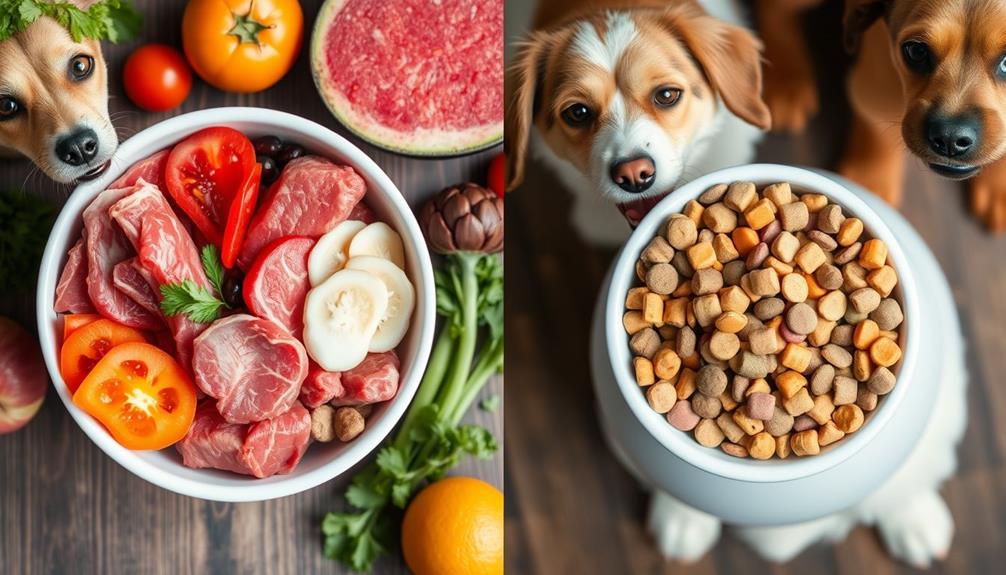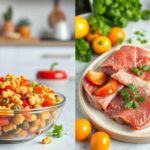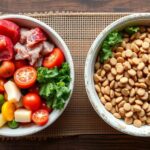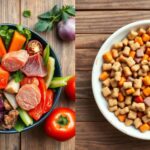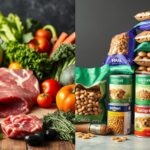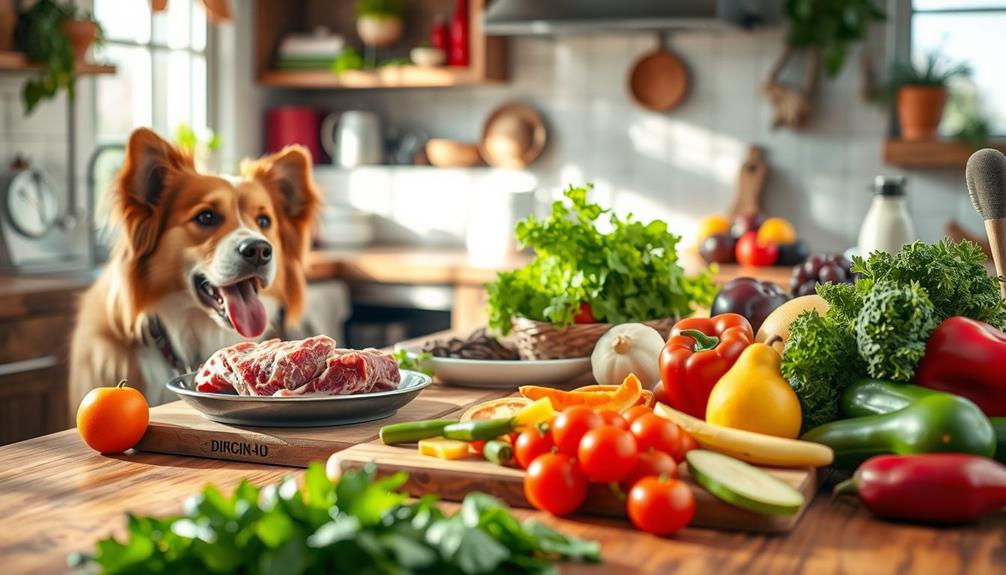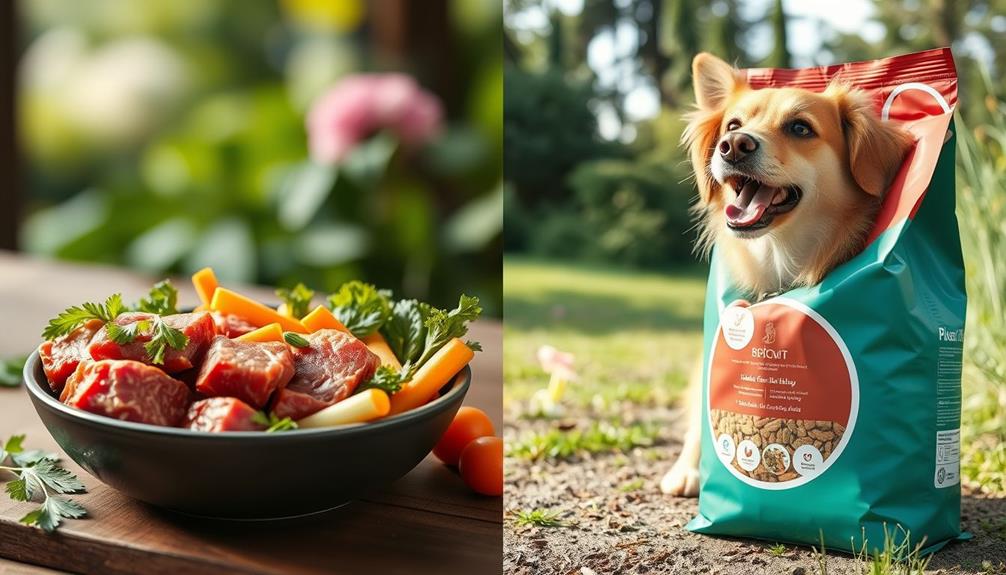When deciding between raw food and kibble for your dog, it's essential to weigh the pros and cons. Kibble is often convenient and meets nutritional standards, while raw diets can offer higher moisture and nutrient levels. However, raw food may carry risks of bacteria and nutritional imbalances. Many dogs thrive on kibble, maintaining good health and energy. You can even enhance kibble by mixing in fresh foods. Ultimately, both diets can support your dog's health with proper management. Discovering the right balance for your pup requires careful consideration of their needs. There's more to explore about these options!
Key Takeaways
- Both raw food and kibble can meet dogs' nutritional needs if properly balanced and managed.
- Raw diets may offer higher moisture and nutrient density but come with risks of bacterial contamination and nutritional imbalances.
- Kibble is convenient and can be nutritionally adequate, with many brands meeting AAFCO standards.
- Dogs can thrive on either diet, but individual health responses may vary; some dogs may benefit from mixed feeding.
- Consulting a veterinarian is essential for tailored dietary advice and ensuring balanced nutrition for your dog.
Myths About Raw Feeding
When it comes to feeding your dog, there are quite a few myths surrounding raw diets that can lead to confusion. One common misconception is that all kibble diets are harmful. In reality, many high-quality kibble options meet AAFCO standards and can provide the nutritional balance your dog needs.
Some pet owners believe that changing to raw food guarantees better health outcomes, but numerous variables can influence a dog's health, regardless of the diet type. Additionally, just like with other pets, providing a proper diet is essential for overall well-being; for instance, proper hamster care emphasizes the importance of balanced nutrition.
Another myth is that raw feeding is the only way to offer fresh, nutritious food. You can easily incorporate fresh foods into a kibble diet without fully adapting to raw. It's also important to note that claims of significant health improvements from raw diets compared to kibble are often exaggerated. Many dogs thrive on kibble, maintaining good health and vigor.
Understanding these misconceptions can help you make informed choices for your furry friend. Always consult your veterinarian to find the best dietary approach for your dog, whether it's raw food diets or quality kibble. Keeping your dog's health in mind is what truly matters.
Health Risks of Raw Diets
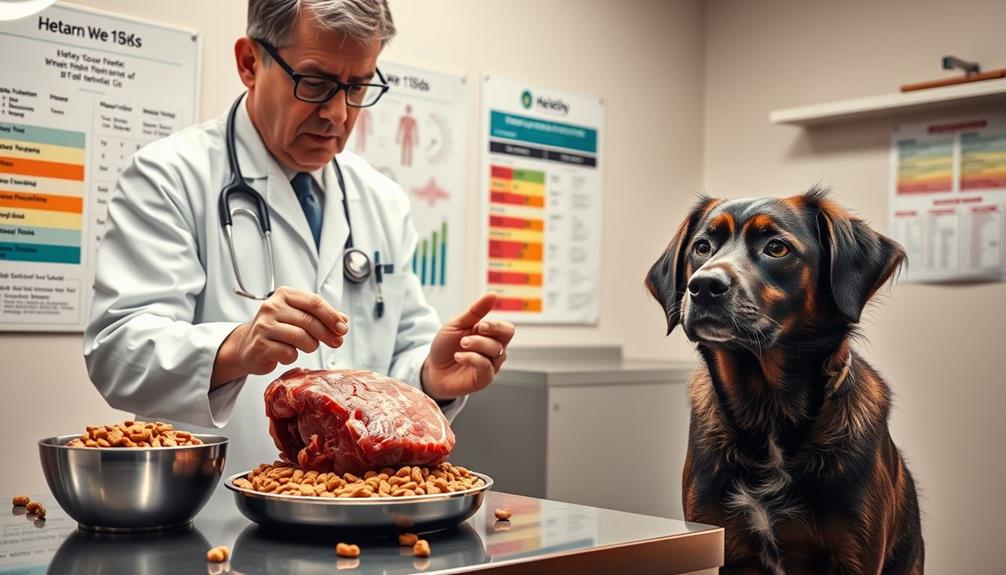
The health risks associated with raw diets for dogs are significant and shouldn't be overlooked. One of the primary concerns is the presence of harmful bacteria, such as Salmonella, which can affect both your dog and your family, especially if you have vulnerable individuals in your household.
Additionally, unbalanced raw diets can lead to nutritional deficiencies over time, as they often lack essential nutrients like calcium and phosphorus, essential for your dog's health. It's important to reflect on the potential impact of dietary choices on overall well-being, as highlighted by the importance of long-term financial planning for assisted living needs.
Feeding whole bones in raw diets poses further dangers, as they can cause choking, dental fractures, or even internal injuries if not handled properly. Puppies, in particular, are at risk when fed improper calcium-phosphorus ratios, which can result in bone deformities and lifelong health issues.
Moreover, altering your dog to a raw diet abruptly can increase the risk of gastrointestinal upset, highlighting the importance of careful dietary management. It's vital to weigh these health risks before committing to a raw diet, as the potential for serious health issues can outweigh the perceived benefits.
Always consult your veterinarian to guarantee your dog's nutritional needs are being met safely.
Cost Comparison: Raw Vs. Kibble
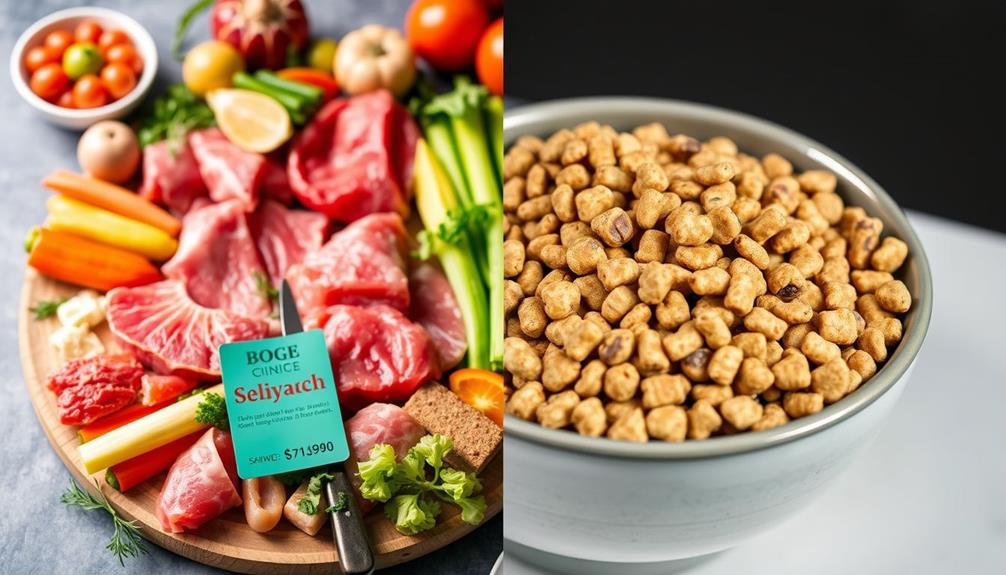
Although many dog owners are drawn to the idea of raw feeding for its perceived health benefits, the financial implications can be significant.
When considering the cost comparison between raw food and kibble, it's crucial to weigh various factors:
- Daily Costs: Raw feeding can range from $3 to over $10 daily, while kibble costs between $1 and $13. Additionally, incorporating healthy dog snacks can further elevate the overall costs of a raw diet but may enhance your pet's nutrition and satisfaction.
- Ingredient Quality: High-quality meat makes up about 70% of a raw diet, driving up expenses.
- Meal Preparation: Raw feeding requires a time investment of 4-5 hours bi-weekly for sourcing and preparing meals, unlike the convenience of simply pouring kibble.
- Annual Vet Costs: Despite claims of reduced vet bills with raw diets, studies show that annual vet costs tend to remain the same, regardless of the type of food.
Observations on Dog Health
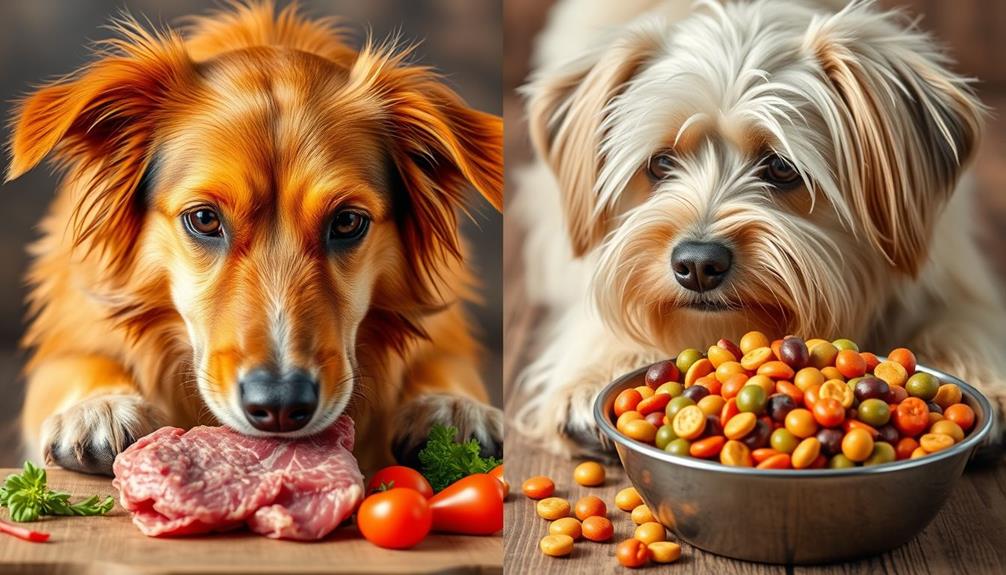
When it comes to dog health, the differences between raw food and kibble aren't as clear-cut as you might think. Observational studies show that many dogs remain healthy on both diets, with no significant changes in allergies or energy levels.
Additionally, some pet owners note that a raw food diet may help improve skin and coat conditions, although this can vary widely among individual dogs.
While some owners swear by raw feeding, the benefits can vary greatly from one dog to another, suggesting that a high-quality kibble can also meet your pet's nutritional needs effectively recommendations for usage based on symptoms.
Health Outcomes Compared
Many dog owners frequently observe that their pets maintain good health and coat condition on both kibble and raw diets. In fact, there's no significant health improvement noted on a raw food diet compared to kibble.
Annual veterinary exams reveal that dogs switching back to kibble after a raw diet show no decline in health, indicating both diets can be adequate. Additionally, ensuring a balanced diet can be essential for overall health, much like the importance of antioxidants in Cranberry Juice Consumption.
Here are some key observations about health outcomes:
- Allergies & Energy Levels: Many pet owners report no change in allergies or energy levels between dogs fed raw food and those on kibble.
- Individual Dietary Responses: Each dog may react differently to diets, showcasing the variability in individual dietary responses.
- Health Benefits: Limited evidence supports significant health benefits of commercial raw diets over high-quality kibble; some dogs thrive on kibble just as well.
- Vitamin & Mineral Intake: You can enhance vitamin and mineral intake by incorporating fresh foods, without needing a complete switch to raw diets.
Ultimately, both kibble and raw diets can support your dog's health, so choose what works best for you and your pet.
Dietary Impact Observations
Observations on dietary impacts reveal that both kibble and raw diets can effectively support your dog's health. Studies indicate that switching from kibble to raw food often shows no significant health improvements. Many dogs maintain good health and coat condition while on kibble alone. Additionally, owners report unchanged levels of allergies and energy between dogs fed raw versus those on kibble diets.
Annual veterinary exams further confirm this, showing no decline in health for dogs that returned to kibble after trying raw diets. While some claim health benefits of commercial raw diets, the evidence is limited; numerous dogs thrive on high-quality kibble.
To enhance your dog's nutritional intake without a complete switch to raw diets, consider adding fresh food. This balanced approach can improve overall health.
| Diet Type | Observations | Health Outcomes |
|---|---|---|
| Kibble | Maintains good health and coat | No decline in health |
| Raw Food | No significant health improvements | Unchanged allergies |
| Fresh Food | Enhances nutrient intake | Supports balanced nutrition |
Alternatives to Raw Feeding
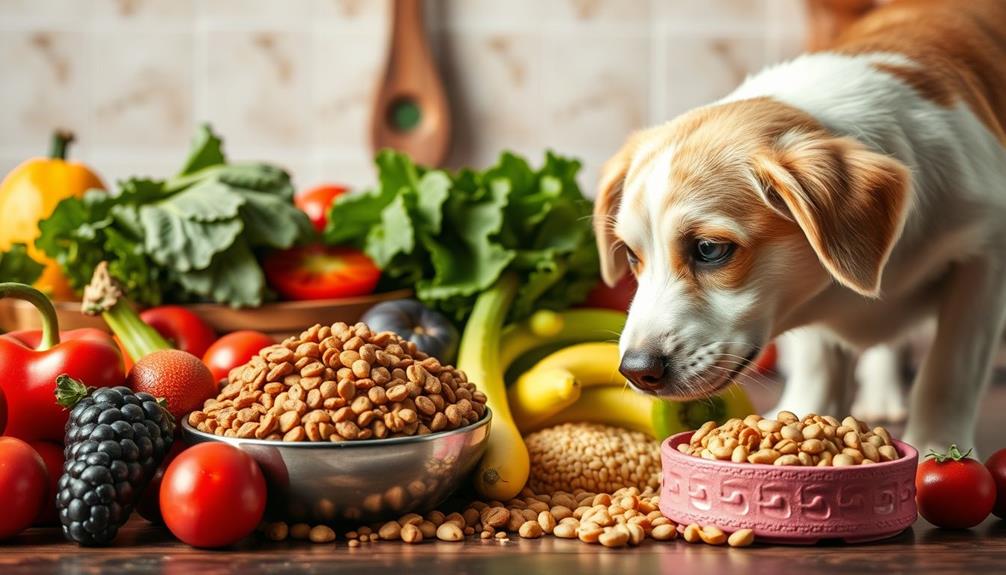
There are several effective alternatives to raw feeding that can still provide your dog with the nutrients they need. If you're looking for options, consider the following:
- Fresh food additions: Incorporate fruits and vegetables into your dog's diet for essential vitamins and minerals without a full replacement to raw feeding. Many of these fresh foods are also safe and nutritious, much like the best educational construction toys for toddlers that promote healthy development.
- High-quality kibble: Opt for nutritionally balanced, vet-approved kibble that offers convenience and cost-effectiveness while supporting your dog's health.
- Mixing kibble with raw toppers: This approach allows you to enjoy the benefits of raw nutrients while maintaining the ease of kibble. It's a great way to add variety to your dog's meals.
- Limited ingredient diets (LIDs): If your dog has food sensitivities, LIDs minimize allergens and provide simple nutrition without the complexities of raw feeding.
You might also explore subscription services that offer customizable meal plans tailored to your dog's specific needs.
These options guarantee balanced nutrition while providing the convenience that busy pet owners appreciate. With these alternatives, you can keep your dog healthy without the commitment of a raw diet.
Nutritional Characteristics of Kibble
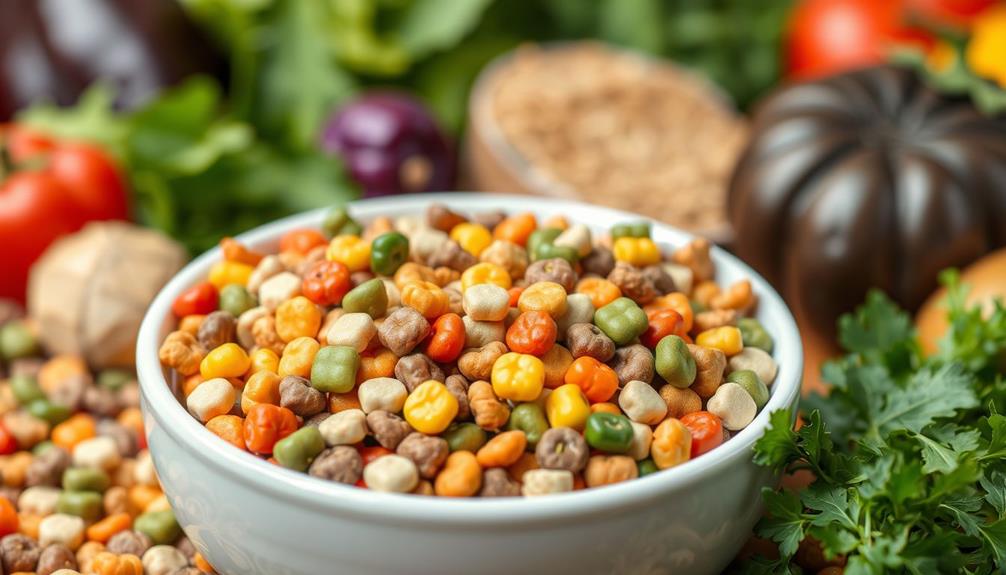
Kibble serves as a convenient and popular choice for dog owners, but understanding its nutritional characteristics is vital for your pet's health. Typically, kibble consists of 5-10% moisture, leading to a high carbohydrate content that can range from 40-60%. This high carbohydrate level may contribute to obesity and gut microbiome issues if not managed properly.
Additionally, some pet owners have found success with best vacuums for dust removal to help maintain a clean environment, which can also play a role in your dog's overall health.
The quality of kibble varies widely, largely depending on ingredient sourcing and processing. Some brands might use low-quality ingredients, including byproducts and spoiled foods, which can adversely affect your dog's health and well-being.
To guarantee nutritional balance, kibble must meet USDA regulations for safety and adequacy, requiring that a protein source is listed as the first ingredient.
However, it's important to be aware that certain kibble brands may also contain added sugars and preservatives to extend shelf life. These low-quality additives can compromise the nutritional value of the food.
Nutritional Characteristics of Raw Food
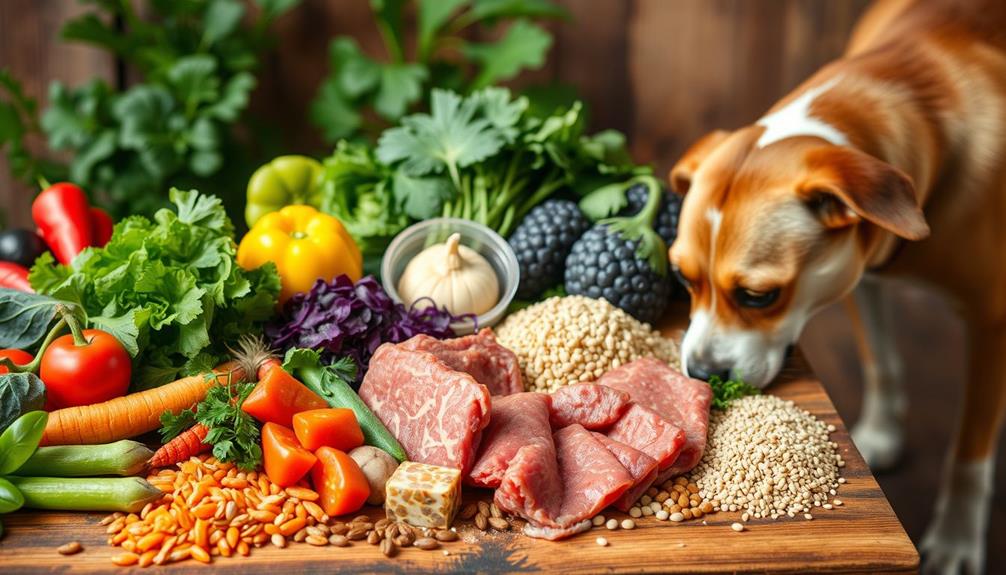
When you consider raw food for dogs, you'll notice its nutrient density often surpasses that of kibble.
Raw diets can support effective strategies for weight loss in dogs due to their high moisture content of 70-75%, which can help keep your dog better hydrated, essential for overall health.
Plus, the lower carbohydrate levels in raw food may aid in preventing obesity and related issues, making it a compelling choice.
Nutrient Density Comparison
Choosing a diet for your dog involves understanding the nutrient density of what you're feeding them. When considering raw dog food versus kibble, several factors come into play that can greatly impact your dog's overall health.
Raw food diets often enhance nutrient absorption due to minimal processing, which allows for better access to vital vitamins and minerals. Additionally, they promote weight loss through low-calorie, high-fiber foods, contributing to a healthier weight for your dog.
- Protein Quality: Raw diets often use fresh, whole ingredients, providing higher protein quality that supports muscle health.
- Carbohydrate Content: Raw food is low in carbohydrates, typically under 10%, which aligns more closely with a dog's natural dietary needs compared to kibble's 40-60%.
- Nutritional Benefits: Many dog owners report improved skin and coat condition and better digestion when switching to raw diets. Supports healthier skin and coat
- High-Quality Ingredients: Sourcing high-quality ingredients in raw diets enhances nutrient bioavailability, while kibble may include byproducts and suffer from quality variations.
While raw dog food offers these advantages, it's important to be cautious of potential bacterial contamination.
Understanding these nutrient density differences can help you make informed decisions that promote your dog's health and well-being. Ultimately, the choice you make can lead to considerable improvements in your furry friend's life.
Moisture Content Benefits
Offering a diet rich in moisture can greatly enhance your dog's overall health. Raw dog food typically contains 70-75% moisture, considerably higher than kibble's 5-10%. This higher moisture content promotes better hydration, which is vital for preventing urinary tract issues and supporting overall digestive health.
Additionally, understanding the importance of budgeting for pet care can help guarantee you provide the best nutrition for your furry friend. When your dog consumes raw food, the increased hydration can lead to smaller and less odorous stools, as their bodies digest raw food more efficiently.
If your dog isn't a big drinker, the hydration provided by raw food can be especially beneficial. It helps maintain proper hydration levels, which is essential for peak organ function. Well-hydrated dogs tend to have better energy levels, allowing them to play, exercise, and enjoy life to the fullest.
Incorporating raw dog food into your pet's diet can be a game changer, guaranteeing they receive the moisture required for their overall well-being. By prioritizing moisture content, you're not only enhancing their hydration but also supporting their digestive system and overall health.
Making this shift could lead to a happier, healthier pup.
Balancing Raw and Kibble
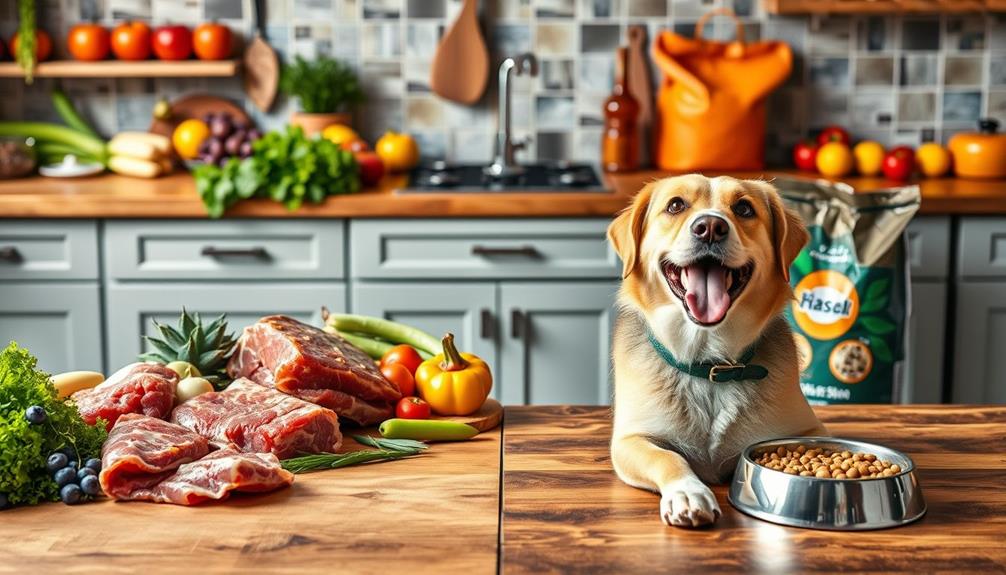
Balancing raw food and kibble in your dog's diet can create a nutritious and convenient feeding routine. By combining these two options, you can enhance your dog's meal while addressing specific dietary needs. Here are some key points to reflect on:
- Use raw toppers: Adding raw toppers to kibble boosts hydration and nutrient intake without needing a complete diet overhaul.
- Gradual changes: Introduce raw and kibble slowly to prevent digestive upset, especially if your dog has a sensitive stomach.
- Moisture content matters: Raw food provides extra moisture, which can be beneficial, especially for dogs that don't drink enough water.
- Overall nutritional adequacy: Mixing raw and kibble helps guarantee your dog receives a balanced diet, catering to their specific dietary needs, like allergies or weight management.
This balanced approach allows pet owners to enjoy the best of both worlds, leveraging the convenience of kibble while reaping the benefits of raw food.
With thoughtful planning, you can create an enjoyable feeding experience that supports your dog's health and happiness.
Expert Recommendations for Owners
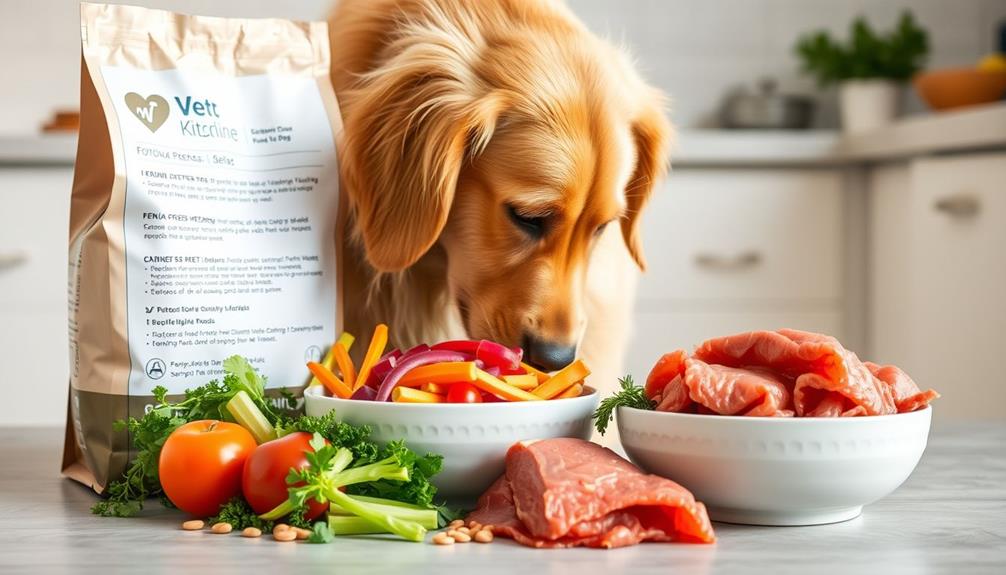
How can you assure your dog thrives on a diet that includes both raw food and kibble? Start by consulting a veterinarian knowledgeable about pet nutrition. They can assess your dog's specific dietary needs and any health conditions that may influence your choices.
When considering raw food, verify it's a balanced diet. Unbalanced homemade raw diets can lead to nutritional deficiencies, so it's essential to do your homework.
While changing to a new diet, monitor your dog's health closely. Watch for any adverse reactions or signs of gastrointestinal upset, and make adjustments as needed.
It's also important to familiarize yourself with proper food handling and sanitation practices to minimize the risk of bacteria when feeding a raw diet.
For convenience, especially if you lead a busy lifestyle, consider mixing kibble with raw toppers. This combination can enhance nutritional value while still being easy to manage.
Frequently Asked Questions
Is Raw Food Healthier for Dogs Than Kibble?
You might think raw food's healthier for dogs, but studies show no significant benefits over kibble. While raw diets can offer advantages, they also pose risks and require careful planning to guarantee nutritional balance.
Do Vets Recommend Kibble or Fresh Food?
Most vets recommend high-quality kibble for its convenience and balanced nutrition. They also suggest incorporating fresh food as a supplement to enhance your dog's diet, ensuring you consult a veterinary nutritionist for proper guidance.
What Do Vets Think of Raw Dog Food?
Vets see raw dog food like a double-edged sword; it can pose serious health risks. They often caution against it due to bacterial contamination and nutritional imbalances, recommending balanced commercial diets instead for your pet's safety.
Should I Feed My Dog Dry or Raw Food?
When deciding whether to feed your dog dry or raw food, consider convenience, nutrition, and cost. Kibble offers ease and balance, while raw food may enhance hydration but requires careful preparation and management to avoid risks.
Conclusion
In the grand tapestry of canine nutrition, both raw food and kibble weave their own unique threads. While raw diets can sparkle with energy, they come with potential pitfalls. Kibble, on the other hand, offers convenience and balanced nutrition. Ultimately, the best choice for your dog lies in understanding their individual needs and preferences. Whether you choose to embrace the raw or rely on kibble, remember, a well-fed dog is a happy dog, and that's what truly matters.

